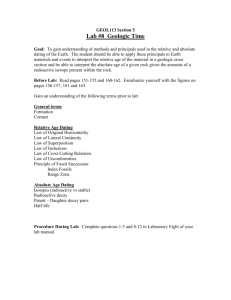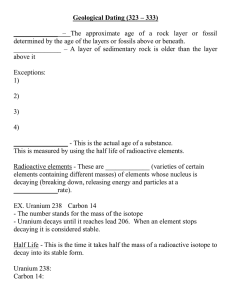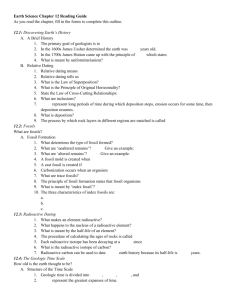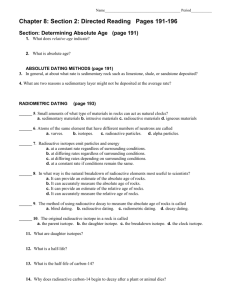Radiometric Dating and the Fossil Record 1 STUDENT NAME:
advertisement
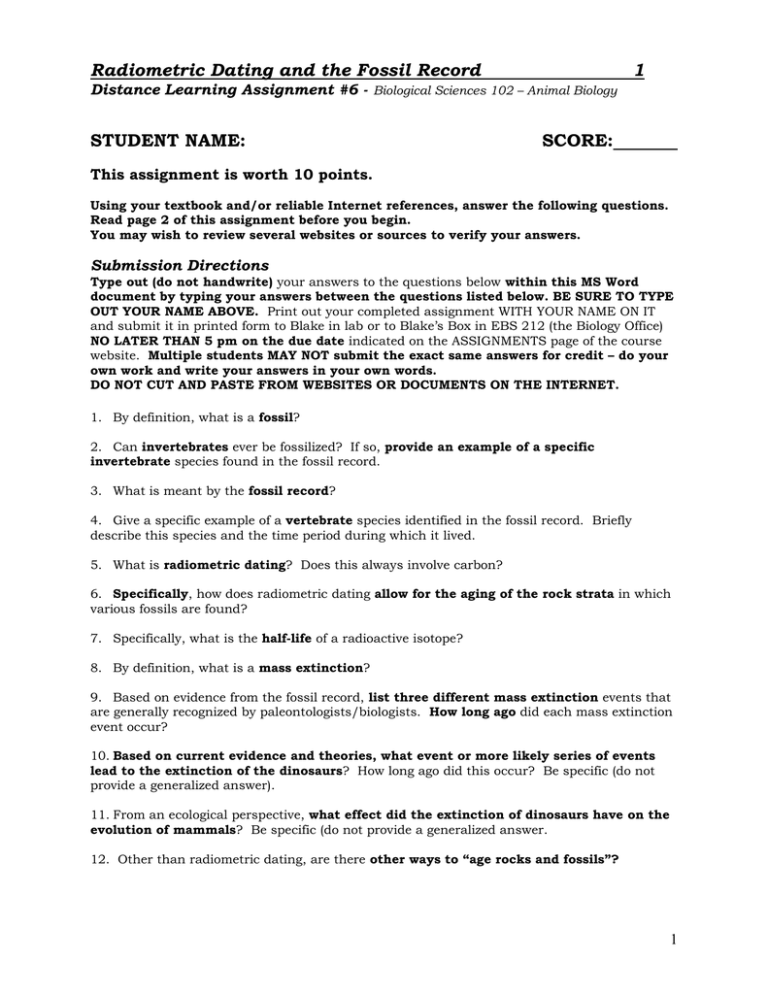
Radiometric Dating and the Fossil Record 1 Distance Learning Assignment #6 - Biological Sciences 102 – Animal Biology STUDENT NAME: SCORE: This assignment is worth 10 points. Using your textbook and/or reliable Internet references, answer the following questions. Read page 2 of this assignment before you begin. You may wish to review several websites or sources to verify your answers. Submission Directions Type out (do not handwrite) your answers to the questions below within this MS Word document by typing your answers between the questions listed below. BE SURE TO TYPE OUT YOUR NAME ABOVE. Print out your completed assignment WITH YOUR NAME ON IT and submit it in printed form to Blake in lab or to Blake’s Box in EBS 212 (the Biology Office) NO LATER THAN 5 pm on the due date indicated on the ASSIGNMENTS page of the course website. Multiple students MAY NOT submit the exact same answers for credit – do your own work and write your answers in your own words. DO NOT CUT AND PASTE FROM WEBSITES OR DOCUMENTS ON THE INTERNET. 1. By definition, what is a fossil? 2. Can invertebrates ever be fossilized? If so, provide an example of a specific invertebrate species found in the fossil record. 3. What is meant by the fossil record? 4. Give a specific example of a vertebrate species identified in the fossil record. Briefly describe this species and the time period during which it lived. 5. What is radiometric dating? Does this always involve carbon? 6. Specifically, how does radiometric dating allow for the aging of the rock strata in which various fossils are found? 7. Specifically, what is the half-life of a radioactive isotope? 8. By definition, what is a mass extinction? 9. Based on evidence from the fossil record, list three different mass extinction events that are generally recognized by paleontologists/biologists. How long ago did each mass extinction event occur? 10. Based on current evidence and theories, what event or more likely series of events lead to the extinction of the dinosaurs? How long ago did this occur? Be specific (do not provide a generalized answer). 11. From an ecological perspective, what effect did the extinction of dinosaurs have on the evolution of mammals? Be specific (do not provide a generalized answer. 12. Other than radiometric dating, are there other ways to “age rocks and fossils”? 1 Radiometric Dating and the Fossil Record 2 Distance Learning Assignment #6 - Biological Sciences 102 – Animal Biology RADIOMETRIC DATING ISOTOPE = an element with a different number of neutrons as compared to the parent element RADIOACTIVE ISOTOPE = an isotope that gives off energy and decays into another isotope Basic Principles 1. Naturally occurring radioactive materials breakdown into other materials at known rates. This is known as radioactive decay. 2. Radioactive parent elements decay to stable daughter elements. 3. Radioactivity was discovered in 1896 by Henri Becquerel. In 1905, Rutherford and Boltwood used the principle of radioactive decay to measure the age of rocks and minerals (using Uranium decaying to produce Helium). The invention of the mass spectrometer after World War I led to the discovery of more than 200 isotopes. 4. Many radioactive elements can be used as geologic clocks. Each radioactive element decays at its own nearly constant rate (the half-life). Once this rate is known, geologists can estimate the length of time over which decay has been occurring by measuring the amount of radioactive parent element and the amount of stable daughter elements. RADIOACTIVE PARENT ISOTOPE POTASSIUM 40 RUBIDIUM 87 URANIUM 235 URANIUM 238 CARBON 14 STABLE DAUGHTER ATOM ARGON 40 STRONTIUM 87 LEAD 207 LEAD 206 NITROGEN 14 HALF-LIFE 1.25 BILLION YEARS 48.8 BILLION YEARS 704 MILLION YEARS 4.47 BILLION YEARS 5730 YEARS CARBON-14 DATING 1. Cosmic rays from the sun strike Nitrogen 14 atoms in the atmosphere and convert them into radioactive Carbon 14, which combines with oxygen to form radioactive carbon dioxide. 2. Living things are in equilibrium with the atmosphere, and the radioactive carbon dioxide is absorbed and used by plants via photosynthesis. Thus, the radioactive carbon dioxide gets into the food chain and the carbon cycle. 3. All living things contain a constant ratio of Carbon 14 to Carbon 12 (about 1 in a trillion). 4. At death, Carbon 14 exchange ceases and any Carbon 14 in the tissues of the organisms begins to decay to Nitrogen 14, and is not replenished by new C-14. 5. The change in the Carbon 14 to Carbon 12 ratio is the basis for dating. 6. The half-life is so short (5730 years) that this method can only be used on materials less than 70,000 years old. Archeological (physical anthropology) dating uses this method. This method is also useful for dating the Pleistocene Epoch (Ice Ages). 7. The method assumes the rate of Carbon 14 production (and hence amount of cosmic ray striking Earth) has been constant (through the past 70,000 years). 2
